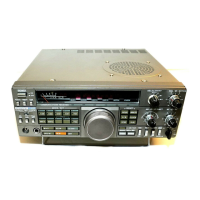FM Mode Step Frequency
Diode D67 controls the step frequency in FM mode when the step switch is on. The
standard step frequency is 2.5 kHz. With D67 cut, the step frequency is 500 Hz. This
modification is only for HF-band FM mode. When the VC-20 VHF option is installed, the
step frequency is already 500 Hz with the step switch on. There is little FM activity on HF.
Unless you know of specific FM transmissions where you need to step in 2.5 kHz
increments, this option should be left alone.
Scan Busy Stop
Diode D68 controls the busy stop in scan mode. The standard scan will stop when the busy
light comes on only in AM or FM modes. With D68 cut, the receiver will stop scanning when
the busy light comes on in all modes. This allows you to use the scan function in SSB, CW
and FSK mode also. Great mod for utility monitoring like military, aircraft, and government
agencies. These guys transmit for a short time (10 seconds or less) and you would miss
most of the transmission if you try finding them with the tuning knob. You can load up the
channels with frequencies and let the receiver scan through them. The radio will stop on the
active channels so you can catch the action, and start scanning again when the activity has
stopped on that channel.
Memory Channel Scroll
Diode D69 controls how memory channels are stored and selected depending upon
whether you are storing a new channel or stepping through channels already programmed.
The standard function allows you to step through all the channels (either empty or
programmed) whether you are programming a channel or selecting a channel to monitor.
With D69 cut, you can only step through the programmed channels in memory mode and
the empty channels are skipped. You will scroll through only those channels with
frequencies in them by using the knob or step keys. Also, with D69 cut, when you are
programming a channel and have pressed the M.IN key, you can only scroll through the
empty channels. The channels already programmed are skipped. This option helps you to
manually scroll through the channels faster and makes finding an empty channel to put a
new frequency into a whole lot easier.
Memory Channel Program
Diode D72 controls how channels that are already programmed are overwritten. The
standard function allows you to program channels even if they are already programmed.
With D72 cut, you cannot program a channel that already has information programmed into
it. The only way to erase a channel is to clear the channel as described in the instruction
manual. Used with the Memory Channel Scroll above, this option prevents you from over
writing a channel with previously-stored important frequencies. If you program and
reprogram channels a lot, this modification is great, but programming the channels using a
computer is faster and easier. See the Remote Control section for computer programming
tips.
5

